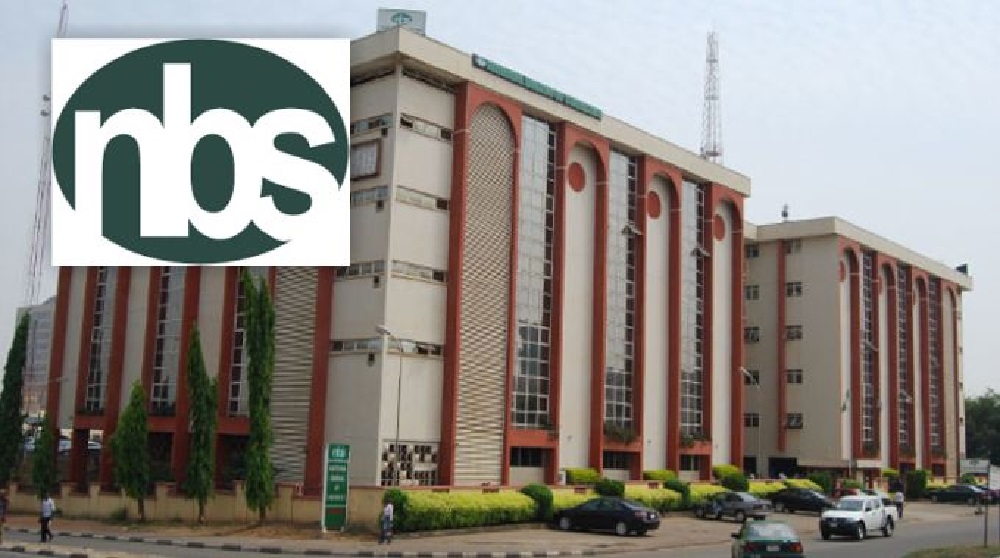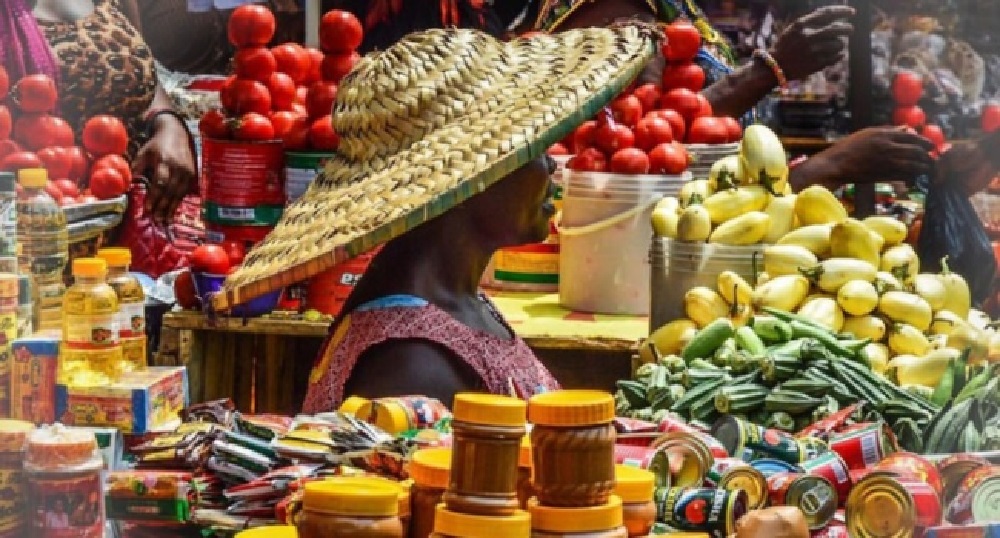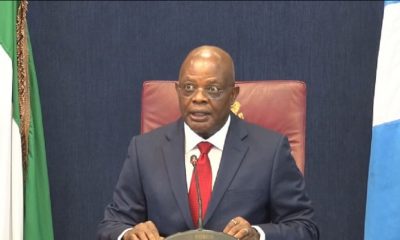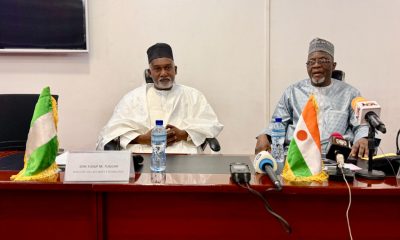Economy
Nigeria’s international trade hit N36.6tn in Q4 2024 – NBS

Nigeria’s total merchandise trade recorded significant growth in the fourth quarter of 2024, driven by a sharp rise in imports and steady export performance.
According to the latest Foreign Trade in Goods Statistics report released by the National Bureau of Statistics on Saturday, total trade for the period stood at N36.6tn, representing a 68.3 per cent increase from the corresponding quarter in 2023 and a 2.2 per cent rise from the third quarter of 2024.
Despite maintaining a trade surplus, the country’s trade balance declined significantly.
The surplus for the quarter stood at N3.42tn, reflecting a 34.9 per cent drop from the previous quarter.
The decline was largely attributed to the continued increase in imports and a marginal drop in export earnings.
The NBS report stated, “Nigeria’s total merchandise trade stood at N36,604.83bn in Q4 2024. This represents an increase of 68.32 per cent compared to the value (N21,747.40bn) recorded in the corresponding period of 2023 and a rise of 2.20 per cent over the value recorded in the preceding quarter (N35,818.35bn).”
Total exports in Q4 2024 were valued at N20.01tn, marking a 57.7 per cent increase compared to the same period in 2023.
However, exports declined by 2.55 per cent from the N20.54tn recorded in the previous quarter
Crude oil continued to dominate Nigeria’s exports, accounting for 68.87 per cent of total exports with a value of N13.78tn.
This represented a 33.7 per cent increase from Q4 2023 and a 2.8 per cent rise from Q3 2024. Other key exports included liquefied natural gas, petroleum gases, superior quality cocoa beans, and urea, which contributed significantly to Nigeria’s non-oil export revenue.
The Netherlands emerged as Nigeria’s largest export destination, receiving N2.09tn worth of goods, representing 10.44 per cent of total exports.
France followed with N1.91tn, while Spain recorded N1.74tn. India and Indonesia were also among the top five export partners, with N1.60tn and N1.41tn in trade, respectively.
These five countries collectively accounted for 43.7 per cent of Nigeria’s total exports during the period.
Total imports in Q4 2024 rose sharply to N16.59tn, reflecting an 83.2 per cent increase from the N9.05tn recorded in Q4 2023. Compared to the previous quarter, imports increased by 8.57 per cent from N15.28tn.
However, mineral product imports declined, falling from N5.84tn in Q3 2024 to N4.92tn in Q4 2024, indicating a reduced reliance on imported mineral fuels.
Agricultural imports reached N1.09tn in Q4 2024, representing a 53.4 per cent rise from the same period in 2023.
Raw material imports surged to N2.11tn, marking a 118.2 per cent year-on-year increase. Manufactured goods imports recorded the highest growth, reaching N8.47tn, an increase of 113.3 per cent from Q4 2023.
China remained Nigeria’s top import source, accounting for N4.61tn or 27.8 per cent of total imports. India followed with N1.90tn, while Belgium, the United States, and France contributed N1.39tn, N1.06tn, and N601.28bn, respectively.
The agricultural sector recorded strong growth in Q4 2024, with total agricultural exports valued at N1.54tn, reflecting a 232 per cent increase from the same period in 2023.
Superior quality cocoa beans were the most exported agricultural product, accounting for N836.2bn.
Standard quality cocoa beans followed at N269.3bn, while sesamum seeds were valued at N202.9bn.
Other notable agricultural exports included natural cocoa butter at N104.6bn and shelled cashew nuts at N30.8bn.
Europe remained the dominant market for Nigeria’s agricultural exports, accounting for N986.7bn, while Asia received N474.4bn worth of agricultural products.
The Netherlands and Malaysia were the top buyers of Nigerian cocoa beans, while China and Japan imported significant quantities of sesamum seeds.
Total exports in the solid minerals sector were valued at N60.7bn, reflecting a 69.2 per cent increase year-on-year but a 21.9 per cent decline from Q3 2024.
Cement clinkers and tin ores were the dominant solid mineral exports, with major trading partners including Cameroon and China.
Imports of solid minerals, mainly plasters from Egypt and Tunisia, were valued at N111.8bn during the quarter.
Manufactured goods exports stood at N494.2bn, marking a 110.3 per cent increase year-on-year but a 52.5 per cent decline from Q3 2024.
The top manufactured goods exports included unwrought aluminum alloys, dredgers, and cathodes. Most of Nigeria’s manufactured goods exports were shipped to Africa, followed by Asia and Europe.
Meanwhile, manufactured goods imports surged to N8.47tn, with aircraft parts from France and photovoltaic cells from China among the most imported items.
Trade with African countries remained robust, with total exports valued at N2.04tn, while imports from the continent stood at N514.96bn, representing just 3.1 per cent of total imports. South Africa, Ivory Coast, and Senegal emerged as Nigeria’s top trading partners within Africa.
Within ECOWAS, Nigeria exported goods worth N1.18tn, while imports from the region were valued at N77.1bn. Ivory Coast ranked as Nigeria’s largest ECOWAS export destination, followed by Senegal, Togo, Ghana, and Benin Republic.
The most exported products to ECOWAS included petroleum oils, electrical energy, and cigarettes, while crude palm oil and petroleum bitumen were the most imported products from the region.
The report indicated that 98.8 per cent of Nigeria’s exports in Q4 2024 were transported by sea, with Apapa Port handling 89.6 per cent of total outbound shipments.
Air and road transport accounted for minimal shares of total exports. On the import side, maritime transport remained dominant, accounting for 90.2 per cent of inbound shipments. Apapa Port continued to serve as Nigeria’s major entry point for imports.
Economy
Inflation surged to 24.23% due to escalating cost of living

Inflationary pressure has reappeared as Nigerians grapple with increases in average costs of basic food items and energy.
For the first time after the rebasing of the Consumer Price Index (CPI), headline inflation spiked in March to 24.23 per cent – 105 basis points above the 23.18 per cent recorded in the previous month.
The National Bureau of Statistics (NBS) yesterday indicated that the rate of increase in the average price level was higher in March than the level in February.
In January, the NBS updated the weight and price reference periods in calculation of the CPI to make the inflationary gauge more reflective of changes in consumption patterns and the economy generally.
The rebasing did not only brought the base year closer to the current period from 2009 to 2024, it also introduced some critical methodology changes to improve the computation processes.
After the rebasing, inflation dropped from 34.80 per cent in the pre-rebased period of December 2024 to 24.48 per cent in January 2025. It dropped further to 23.18 per cent in February.
In its latest report, NBS recorded 186 basis points changes between the monthly inflation rate, with the month-on-month rate rising from 2.04 per cent in February to 3.90 per cent in March.
The NBS attributed the spike to the rise in costs of food and alcoholic beverages, fuels and electricity, among other items.
Analysts at CardinalStone said the resurgence was due to renewed foreign exchange (forex) pressures amid heightened global risk-off sentiment.
They pointed at foreign portfolio investments (FPIs) outflows and increased dollar demand, which saw naira dropping by 2.4 per cent in March.
Experts also cited increase in price of Premium Motor Spirit (PMS) or petrol, following the temporary suspension of the naira-for-crude swap arrangement.
Food inflation rate stood at 21.79 per cent in March 2025. The composite food index decreased to 21.79 per cent from 23.51 per cent.
Core inflation, which excludes volatile agricultural produce prices and energy, rose to 24.43 per cent from 23.01 per cent.
Specifically, the month-on-month food inflation rose by 50 basis points from 1.67 per cent in February to 2.18 per cent in March.
The NBS attributed the increase in food inflation to increases in the average prices of basic food items including ginger, garri, broken rice, honey, crabs, potatoes, plantain flour, periwinkle and pepper amongst others.
On a state-by-state basis, food inflation was higher in Oyo with 34.41 per cent; Kaduna (31.14 per cent) and Kebbi (30.85 per cent).
On the other side, the 9.61 per cent recorded by Bayelsa; Adamawa (12.41 per cent) and Akwa Ibom (12.60 per cent), were the lowest inflation rates.
Analysts expressed concerns that the resurgent inflationary pressure might lead to renewed tightening stance by the Central Bank of Nigeria (CBN).
CBN Governor Dr. Olayemi Cardoso, had at the end of the first Monetary Policy Committee (MPC) meeting in 2025, reiterated the apex bank’s commitment to orthodox monetary policies, noting that the apex bank’s stance will be reflective of the inflationary trend.
With inflation rate dropping in February, the MPC had decided to maintain all key monetary policy parameters, including the Monetary Policy Rate (MPR) at 27.50 per cent, the asymmetric corridor around the MPR at +500/-100 basis points, the Cash Reserve Ratio (CRR) at 50.00 per cent for Deposit Money Banks and 16.00 per cent for Merchant Banks, and the Liquidity Ratio at 30.00 per cent.
Clarifying the impact of the rebased CPI, Cardoso had explained that the lower inflation figure should not be misinterpreted.
He underlined the need to analyse more data before drawing comparisons, noting that the CBN is currently assessing the figures and will provide further guidance in due course.
The CBN boss stressed the critical importance of collaboration between monetary and fiscal authorities in sustaining recent economic improvements.
Addressing concerns about the impact of elevated borrowing costs on economic growth, the CBN governor assured that the apex bank’s primary objective is to stabilize the foreign exchange and financial markets.
He expressed confidence that such stability would attract increased foreign investments, stimulating the much-needed economic growth.
Cardoso also highlighted the competitiveness of the Nigerian currency, which has spurred growing interest from international investors.
Economy
SEE Current Black Market Dollar (USD) To Naira (NGN) Exchange Rate

The exchange rate between the US dollar and the Nigerian naira continues to draw significant attention from individuals and businesses alike, especially those involved in international trade and remittances.
On Saturday, April 12, 2025, activity in the Lagos parallel market, commonly known as the black market shows that the buying rate for one US dollar stands at ₦1570, while the selling rate is ₦1575.
These figures are sourced from traders and Bureau De Change (BDC) operators who are active in key currency exchange hubs across Lagos.
Why the Black Market Rate Matters
Although the Central Bank of Nigeria (CBN) does not officially recognize or support the use of the black market for foreign exchange transactions, many Nigerians still rely on it due to difficulties in accessing forex through official banking channels. Issues such as limited availability, long processing times, and strict documentation requirements have made the black market a more accessible, albeit riskier, alternative.
CBN’s Official Position
The CBN continues to warn against participating in parallel market trading, stating that such activities undermine the stability of the national currency. The apex bank urges those in need of foreign currency to apply through authorized financial institutions, which are mandated to follow official exchange rates.
Nonetheless, the disparity between the official and unofficial markets persists, often influenced by market forces such as demand, inflation, and fluctuations in Nigeria’s foreign reserves.
Latest Exchange Rates Overview
Black Market (Parallel Market) Rate
Currency Pair Buying Rate Selling Rate
USD/NGN ₦1570 ₦1575
CBN Official Rate
Currency Pair Highest Rate Lowest Rate
USD/NGN ₦1630 ₦1570
Key Notes for Forex Users
The exchange rates in the black market often differ slightly from one location or dealer to another due to market volatility and negotiation margins.
Rates can also fluctuate within hours based on economic news, government policies, and global financial trends.
It is advisable to compare rates from multiple sources before conducting any large transactions, especially in volatile markets.
What This Means for Nigerians
The current forex rates reflect continued pressure on the naira, and many analysts believe that inflation, reduced oil revenue, and inconsistent monetary policies are key factors driving the demand for the dollar. For everyday Nigerians, this means the cost of imported goods remains high, and businesses dependent on international suppliers face growing challenges.
Until forex supply stabilizes through official channels, the black market will likely remain a major player in Nigeria’s currency landscape.
Economy
CHECK Exchange Rate As Naira Weakens More In Parallel Market

Naira has continued its downward slide in the parallel market on Thursday, exchanging at N1,621/$1, a depreciation from N1,580/$1 recorded just a day earlier on Wednesday.
This represents a N41 decline in 24 hours, deepening concerns among traders and economic watchers about sustained volatility in the FX market.
While the official exchange rate stood at N1,644.00/$1 on Wednesday, according to figures published on the Central Bank of Nigeria (CBN) website, there was no updated official rate published by the CBN several hours after the market close on Thursday.
Meanwhile, market participants at Wuse Zone 4 in Abuja attributed the persistent depreciation to a resurgence in speculative activities, unmet demand from importers, and lingering confidence issues in the foreign exchange market.
Alhaji Aminu Gwadabe, President of the Association of Bureau De Change Operators of Nigeria (ABCON), attributed the ongoing volatility in the forex market to a mix of local and global uncertainties. In a message sent to Nairametrics, he stated:
“The volatility, fears, happenings, and shocks in both the local and international markets called for disdain.
President Trump’s tariff announcements have sent markets into panic, loss of confidence, revenue losses, and budget reviews.”
He added that despite ongoing interventions by the CBN, instability persists.
“As usual, the CBN, being a catalytic actor, must continue to ensure stability through timely interventions. However, volatility remains a challenge and needs to be more comprehensively addressed,” Gwadabe said.
He further called for an expanded policy transmission mechanism to better serve the retail end of the FX market.
“It is therefore necessary for the CBN to reevaluate the efficacy of that Policy transmission mechanisms and expand its scope to the BDCs retail segment of the market to cater for the needs of the critical retail needs of invisible transactions where the BDCs pose the most potent tool of the CBN policy transmission mechanism.”
Dr. Muda Yusuf, CEO of the Centre for the Promotion of Private Enterprise (CPPE), also linked the naira’s recent struggles to global developments and speculative pressures.
“This is not unconnected to recent policy signals from President Trump and global oil price movements. The market is heavily information-driven, and speculative pressure has spiked following the tariff announcements,” Yusuf explained.
“Now that Trump appears to be having second thoughts, we might even see a bit of a breather in the FX market,” he added.
Meanwhile, traders on the ground say the situation is being worsened by the uncertainty surrounding ongoing government reforms and inconsistent access to official FX windows.
“The demand today was unusually high, especially from small businesses that can’t access the banks. It’s putting pressure on our supply,” a trader at Abuja’s Wuse Zone 4, who asked not to be named stated.
The spread between the official exchange rate of N1,644/$1 and the parallel market rate of N1,621/$1 narrowed slightly on Thursday, a sign that some convergence may be taking place, despite persistent volatility.
Market analysts warn that unless the CBN resumes consistent interventions or significantly boosts FX liquidity, the naira may continue to face downward pressure in the weeks ahead
The continued slide of the naira, despite heightened CBN interventions, signals persistent challenges in Nigeria’s FX liquidity and structural demand-supply mismatch.
-

 News4 hours ago
News4 hours agoBREAKING: Unknown gunmen reportedly storm Senator Natasha’s family residence
-

 News12 hours ago
News12 hours ago“How my father escaped assassination” – Bishop Oyedepo’s daughter
-

 News7 hours ago
News7 hours agoSnub story on removal of Rivers Sole Administrator, it’s FAKE-Chief Registrar
-

 News13 hours ago
News13 hours agoFG expresses sympathy for CBEX victims, urges a united effort to combat Ponzi schemes
-

 News6 hours ago
News6 hours agoSAD! Again, Alleged Herdsmen Attack Three Benue Communities
-

 News19 hours ago
News19 hours agoEl-Rufai labels Tinubu’s government ‘worst in Nigeria’s history’
-

 News13 hours ago
News13 hours agoWoman tragically lost her life after attempting to flee through glass door during alleged incident of domestic violence
-

 News19 hours ago
News19 hours agoNigeria-Niger Vow to Strengthen Ties, Tackle Border Security






